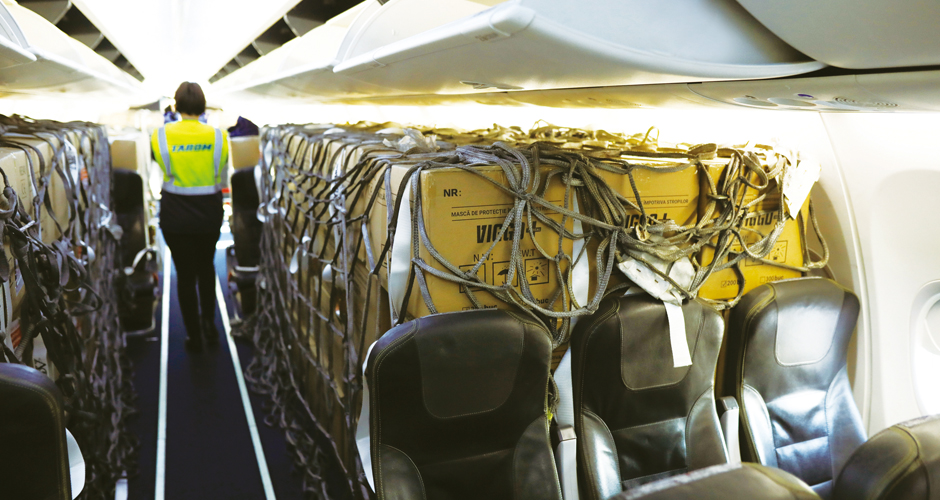 17th December 2020
17th December 2020
As people stopped flying around the world because of the pandemic, passenger flights were cancelled and aircraft are now parked at airports or longer term in the deserts of the US and Australia.
Fewer flights mean there is a squeeze on air cargo capacity, as most freight is carried in the belly space of passenger aircraft. Many carriers have quickly adapted a proportion of their passenger aircraft to carry light freight in the upper deck and heavy cargo in the belly space.
Increased demand for airfreight has largely been generated by growing numbers of on-line consumer purchases during the pandemic. This rise in e-commerce is a result of lockdowns and other restrictions on movement, which means many people are unable to shop at retail outlets.
According to the latest reports from the International Air Transport Association the ongoing capacity crunch continues to be driven by the lack of international passenger traffic. In August, international belly cargo capacity was down 67 percent Year-on-Year, a move in the right direction following the crash of 82 percent in April this year.
The number of widebodies – the main aircraft type for belly-hold cargo – in service in the passenger fleet has been rising since March. However, the widebody fleet size was still down 42 percent in July, compared to the same period in 2019.
Airlines have been trying to grow their freighter fleets and optimise their utilisation. In June, daily utilisation of widebody freighters rose to its highest level since 2012, at close to 11 hours a day. In parallel, freighters Air Cargo Tonne Kilometres (ACTK) were up 28 percent Year-on-Year in August, according to the IATA report (August 2020).
Air cargo demand has strengthened during this year, although Year-on-Year the volumes have decreased when compared to 2019, according to Greg Knowler, Europe Editor for Journal of Commerce.
“The August figures for air cargo volume out of China through August traditionally an off-peak season continued to improve, driven by a rise in demand for e-commerce products from consumers,” said Knowler.
In early October there was a mixed bag of figures from WorldACD which showed that rates had declined in most markets. In the report it shows that cargo yield had moved up and that rates will climb for the rest of the month.
Overall capacity declined by 1 percent worldwide, with Africa bucking the trend with a 4 percent increase while Asia Pacific saw a 4 percent decline.
WorldACD data analysis shows that in August, of 1.5 million shipments, there was a 17.2 percent Year-on-Year (YoY) drop in worldwide air freight volume and a corresponding fall of 29 percent in shipments carried. Very surprisingly there was a 37 percent increase in US dollar revenues as rates increased by 65 percent when compared to the year before.
Asia Pacific lost the least volume at 10 percent while origin cargo in Europe lost 25 percent, Middle East & South Asia region dropped 22 percent, according to WorldACD.
In terms of airport cargo volumes, Hong Kong maintained its position as the number one airport in the world for the first half of 2020 when compared to the same period the year before, despite a 10 percent drop in volumes.
“Not a single day passes without news about an upcoming capacity shortage: ‘regular’ autumn shipments coming in or vaccines against COVID-19 hitting the market. Charter capacity is more difficult to come by. Ever since our industry was severely hit by the effects of the pandemic, predictions and reports about sky-high rates have abounded. The most exotic figures doing the rounds, look to be based on incidental shipments,” said Knowler.
It is expected that the traditional end of year peak for air cargo, normally starting late in the fourth quarter, will start at the end of September. This is due to the launch of a wide range of smartwatches, phones, and other electronic consumer devices products which will limit air cargo capacity further and increase rates.
Robert Frei, Business Development Director at TAC Index said that air freight is now the main source of revenue for carriers and forwarders. ‘The importance of air cargo to the recovery of global trade has become very visible and recognised,’ he told Cargo Trends website.
Despite those positive signs, improvements in air cargo demand growth have been slow since May. Air freight typically tends to lose market share of global trade at the start of downturns, as shippers turn to cheaper but slower ocean transport. Air cargo would then rebound, when businesses need to rapidly refill inventories amid rising demand.